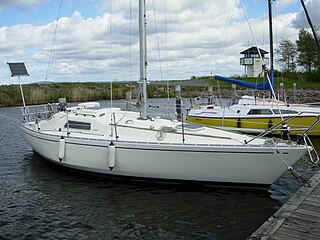
Yacht racing is a sailing sport involving sailing yachts and larger sailboats, as distinguished from dinghy racing, which involves open boats. It is composed of multiple yachts, in direct competition, racing around a course marked by buoys or other fixed navigational devices or racing longer distances across open water from point-to-point. It can involve a series of races when buoy racing or multiple legs when point-to-point racing.

A maxi yacht usually refers to a racing yacht of at least 21 metres (70 ft) in length.

World Sailing (WS) is the world governing body for the sport of sailing recognized by the International Olympic Committee and the International Paralympic Committee (IPC).
One-Design is a racing method which may be adopted in sports which use complex equipment, whereby all vehicles have identical or very similar designs or models.
The International Offshore Rule (IOR) was a measurement rule for racing sailboats. The IOR evolved from the Cruising Club of America (CCA) rule for racer/cruisers and the Royal Ocean Racing Club (RORC) rule.

Ronald John Holland is a yacht designer, who came to prominence in the 1970s with his successful racing designs, and is now best known for his superyachts such as Mirabella V and Ethereal. He is now based in Vancouver, British Columbia, Canada.

The One Ton Cup is a trophy presented to the winner of a sailing competition created in 1899 by the Cercle de la voile de Paris (CVP).
Gary Mull was an American yacht designer who created many popular fiberglass sailboats.
IRC is a system of handicapping sailboats and yachts for the purpose of racing. It is managed by the Royal Ocean Racing Club in the United Kingdom through their dedicated Rating Office. and UNCL in France.
Lawrence Karl Davidson was a New Zealand sailing yacht designer. He is most notable for his International America's Cup Class sailboats which successfully challenged and defended the America's Cup sailing trophy.
The International Measurement System (IMS) is a system of handicapping sailboats for the purpose of racing that replaced the earlier International Offshore Rule (IOR) system in the early 1990s. It is managed by the Offshore Racing Congress (ORC). In the sailing world it is usually referred to simply as 'IMS'.
The Seaway 25 was designed by Doug Peterson of USA fame for Tom Stevenson in 1978 after Tom won the World half Ton championship in one of Doug's designs. The yacht was designed to sail well on the short sharp chop of Port Phillip Bay Melbourne Australia. Intended to rate as a quarter ton Trailer yacht under IOR and Junior Offshore Group racing both for Harbour and Inshore Yacht racing.

Syd Fischer, is an Australian businessman and property developer and sailor.

The Transpac 52 (TP52) is a class of yacht used for competitive 52 Super Series yacht racing, and the Audi MedCup previously, besides the world championship of the class. The class is recognised by the International Sailing Federation which entitles the class to hold an Official World Championships.

Half Ton class was an offshore sailing class of the International Offshore Rule racing the Half Ton Cup between 1967 and 1993.
X-Yachts A/S is a Danish shipyard, located in Haderslev in the southern part of Denmark. The shipyard builds sailboats between 35 and 65 feet.
Three-Quarter Ton class was an offshore sailing class of the International Offshore Rule racing the Three-Quarter Ton Cup between 1974 and 1994.
Quarter Ton Class is an offshore sailing class of the International Offshore Rule racing the Quarter Ton Cup between 1967 and 1996 and from 2005 till now. The class is sailed by smaller keelboats of similar size and is likely the world's most produced keelboat class.
Handicap forms for sailing vessels in sailing races have varied throughout history, and they also vary by country, and by sailing organisation. Sailing handicap standards exist internationally, nationally, and within individual sailing clubs.
The D&M 22 is an American trailerable sailboat that was designed by Sparkman & Stephens as an International Offshore Rule Quarter Ton class racer and first built in 1971. The boat is Sparkman & Stephens' design #2090.









